How Big Of A Hard Drive Do I Need For Windows 10
Did you know that some Windows users pride themselves in stripping the operating system back? It's true; creating a infinitesimal Windows installation package that you could store almost anywhere is the goal. For others, the device they're using dictates the size of the operating system.
There are tools y'all tin use to strip Windows 10 dorsum. Some tools remove bloatware. Others skin back the seemingly useless services that but apply to specific circumstances.
Let's look at how y'all tin continue your Windows 10 installation to a minimum.
How Much Space Does Windows x Need?
At launch, Windows 10 was smaller than its predecessor, Windows 8. That status has since changed, merely more on that in a moment.
The development period between the two operating systems gave Microsoft fourth dimension to streamline aspects of the code, make the transition and introduce new features to keep the operating system footprint down. Despite Windows x arriving with a healthy smattering of new features, the onus was working with limited capacity mobile devices.
However, some of the cutbacks weren't instant hits with desktop and laptop users. While information technology made sense to remove features such as default recovery paradigm creation for mobile devices (while also boosting boot time past a few seconds), those using laptops or desktops would probably take preferred this to remain intact.
That said, it does come down to user preference. I accept a 1 TB hard drive, and a 128 GB SSD installed in my laptop. The operating system is installed on the SSD, and then it boots quicker than Usain Bolt leaping out of the blocks, but I also accept the extra space needed for any recovery backups. A user with a single 64 GB hard bulldoze installed on a tablet is unlikely to feel the same.
Windows 10 Increases in Size
The Windows 10 May 2019 update brought some unwelcome news. Microsoft used the update to increment the Windows 10 installation size from 16GB for 32-fleck, and 20GB for 64-scrap, to 32GB for both versions.
The desperate increase in size relates to an alteration to the Windows ten update process. Previously, an update would take to expect until there was plenty infinite on the host device to download and install. The Windows ten May 1903 update permanently reserves 7GB of deejay space to ensure future updates tin can complete without fault.
Near desktop and laptop users will not find the size requirement an outcome. But mobile users with limited storage certainly will, especially given the storage on many mobile devices is nigh impossible to replace or upgrade.
What does that mean for Windows x users using devices with smaller storage?
Unfortunately, yous will remain stuck on Windows ten version 1809 for the balance of its supported life. That support ends on May 12, 2020. There is also a long-term servicing branch for 1809, delivering bug fixes and security updates until January 2024, and then security fixes only until January 2029.
Given May 2020 is less than a year away already, and users have washed nothing wrong, Microsoft should consider offering each extended user support.
How Does Windows x Salvage Infinite?
At its release, Microsoft proudly announced that Windows 10 "leverages anefficient compression algorithm to compress system files." The operating organisation compression returned "approximately one.v GB of storage for 32-bit and two.half dozen GB of storage for 64-flake Windows."
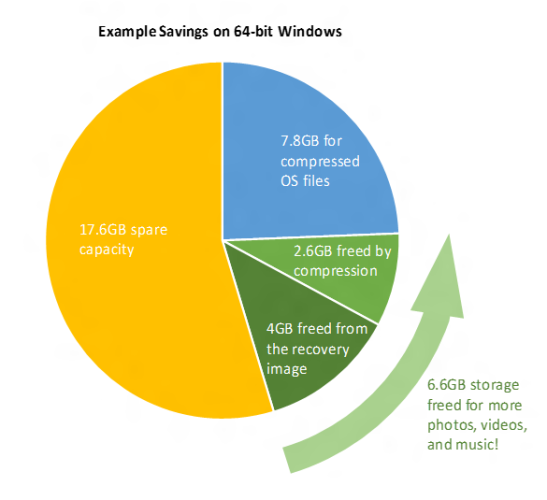
Microsoft'south system works with your hardware. Instead of compressing a standardized file listing, Windows 10 uses the amount of installed RAM to determine how often a file is likely to be recalled. Similarly, if your system has a fast CPU, Windows 10 will compress more than files to brainstorm with---offering farther space savings.
Compact Bone and WIMBOOT
Part of Windows 10 pinch for smaller devices stems from updates to WIMBOOT (Windows Epitome Boot). WIMBOOT originally featured in Windows eight.ane, "enabling specially prepared Windows 8.i devices to have all the goodness of an efficient compression algorithm without compromise to responsiveness." However, only a pocket-size number of Windows 8.1 devices were WIMBOOT prepared.
That inverse with Windows 10. The WIMBOOT compression algorithm is completely integrated with Windows 10. It has a new proper noun, too: CompactOS. The biggest potential saving CompactOS can make is the elimination of the recovery partition, which takes around 4GB of space. Yet, when manufacturers include a custom recovery partitioning, it often comes loaded with bloatware and steals away fifty-fifty more precious storage.
Want to learn more? Hither's how you save even more disk infinite with CompactOS on Windows 10.
Reducing the Windows 10 Installation Size
Let'southward look at a few other easy methods for reducing Windows x installation footprint.
1. Remove Bloatware
Windows 10 comes with a reasonable (or unreasonable, as it were) corporeality of bloatware. Some Windows x pre-installed apps include Microsoft 3D Builder, Processed Vanquish Saga, Groove Music, Money, Weather condition, Music, Sport, and then on. Most Windows x users will have an alternative preference for these apps. Nonetheless, Microsoft bundles them up.
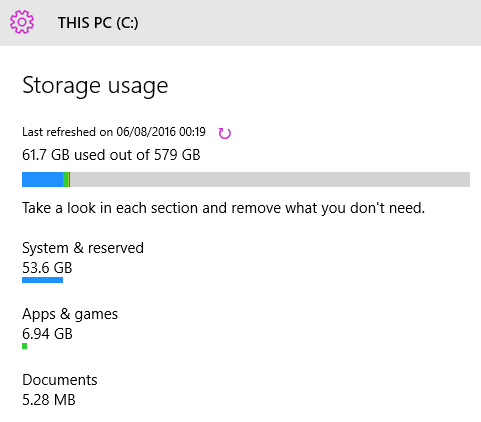
Moreover, removing them is fourth dimension-consuming, and, only returns a fraction of space.
We've detailed how to remove the myriad Windows 10 bloatware apps, or you lot tin can learn how to purge your Commencement Carte du jour of bloatware using i of Tina Sieber's app suggestions to exercise the work for you!
2. Reduce or Remove Hiberfil.sys
Windows x arrives on your system with hibernation turned on past default. Information technology isn't necessarily a bad thing, especially for those with masses of storage. Hiberfil.sys is the hibernation storage file that keeps track of your arrangement vitals. The file stores primal settings the operating system requires to restore from hibernation apace.
The size of your hiberfil.sys file relates directly to the amount of installed organization RAM. It can occupy up to 75% of that amount, besides. For instance, if you have 8GB RAM installed, the hiberfil.sys file could utilise upwardly to 6GB of storage (hard bulldoze storage, not your RAM). The more RAM you have, the more space the hiberfil.sys file will consume.
Want to turn information technology off?
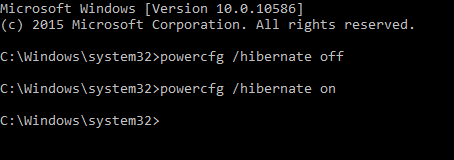
- Type control prompt in your Commencement Menu search bar, right-click the All-time Lucifer and select Run equally Ambassador.
- Now, input powercfg /hibernate off. That's information technology; hibernation is switched off.
- To plough it back on, input powercfg /hibernate on. Again, that's it.
When you plough hibernation off, the hiberfil.sys file should immediately disappear, freeing upwards infinite.
iii. Tweak Your Paging File Storage
Windows has an inbuilt feature called the Paging File. It works somewhat like a virtual retentiveness relief.
Your system has a set amount of installed RAM. Yous cannot exceed the amount of RAM installed on your system. The installed amount is the limit. Notwithstanding, there are times when your organization will butt upwardly against the corporeality of RAM yous have installed.
When that happens, Windows will attempt to use the paging file to offering temporary relief. Some of the important information currently held in the RAM volition temporarily transfer to a file on your hard drive. Equally hard bulldoze memory is much slower than super-fast RAM (even SSDs are slower), recalling this data takes longer. It also increases the wear and tear on your drive as your system performs more read/write operations.
Yous can command the size of the paging file or remove it completely.
Head toControl Panel > System and Security > Organisation. In the left-mitt panel, selectAdvanced system settings. Select theAdvanced tab. NetherPerformance, selectSettings.
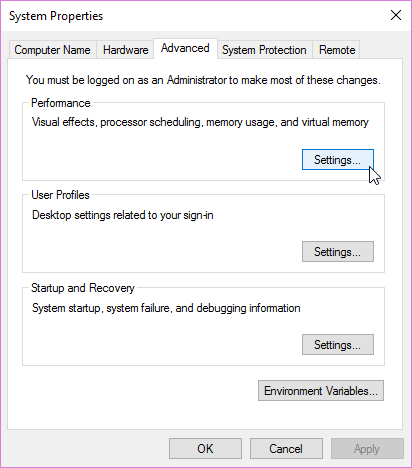
Head to the Advanced tab. Y'all should now see a Virtual Memory panel. Select Change.
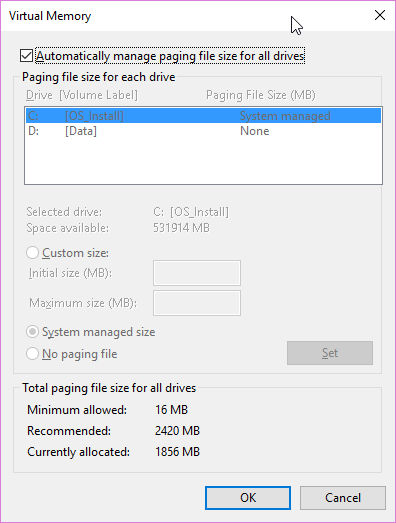
You lot now have iii options:
- Custom size
- System managed size
- No paging file
Y'all tin eliminate the paging file, just I wouldn't suggest that. Even though the paging file exists, information technology isn't necessarily taking upwardly space, specially if you are not using all the RAM bachelor to your system. If yous want, reduce the size of the paging file.
four. Windows.old
When Microsoft releases a major update, Windows 10 creates a Windows.old folder. The Windows.old folder contains your onetime system settings, in case anything goes wrong with the new version. It is a handy organization. But the Windows.quondam folder can sit on your difficult drive for ten days, taking up valuable space, earlier it finally self-destructs. At one bespeak, for various reasons, I ended up with three Windows.sometime files, taking up a huge corporeality of infinite.
You lot tin can delete the Windows.erstwhile folder manually. However, it comes with the warning that once it is gone, information technology isn't coming back, equally information technology is usually too large to send to the Recycle Bin. If y'all need to head back to the previous version of Windows x for any reason, inside the ten days, do not delete Windows.old. It contains your system settings and onetime files, and deleting without a proper backup could lead you into all kinds of bug.
At the very least, you might cry and be angry at me, and I wouldn't like that.
Free Upward Disk Space
The all-time way to remove the Windows.erstwhile file is using the inbuilt Windows Disk Cleanup tool.
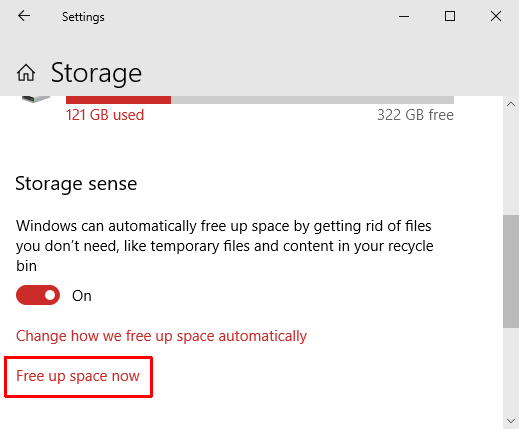
Type complimentary up into your Commencement Bill of fare search bar and select the Best Match. Nether Storage sense, select Free up space at present. Windows x will automatically summate how many temporary files yous can delete, including your Windows.former folder. Make sure to check the Windows Update Make clean-up box. You can also delete the Windows upgrade log files, as they can have upwardly additional space.
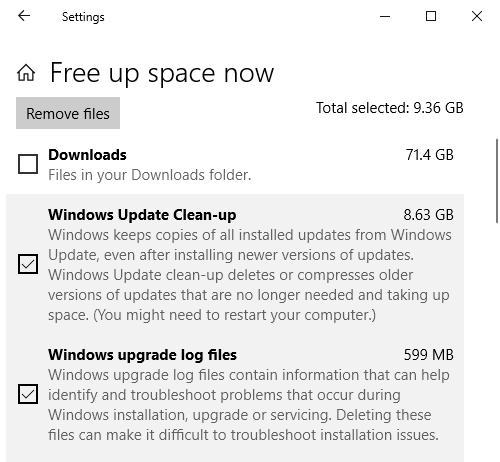
Subtract Windows 10 Space Farther Using WinReducer EX-100
WinReducer EX-100 is a third-political party tool you can utilise to decrease your Windows 10 installation size further. WinReducer is a well-known tool for Windows installation minimalists. Information technology allows you to strip back the installation, removing services and utilities as you encounter fit.
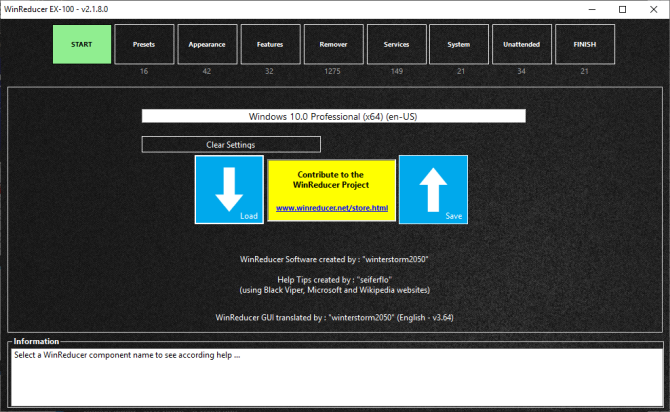
Just make certain you know what you lot're removing. Some Windows services are dependent on others. You might find after installation that something you thought was innocuous is vital to a tool you want to run. WinReducer EX-100 does come with a heap of handy tooltips and an information panel to give y'all an overview. Only if yous're unsure, search the web to figure out if removing a tool volition interruption Windows 10 down the line.
I would advise Windows 10 installation reduction beginners to stick with the WinReducer presets, under the commencement tab.
Download WinReducer for Windows 10 32-bit | 64-bit (Both Free)
Windows 10 Cannot Get Any Smaller
As of the 1903 update, Windows 10 requires a flat 32GB of space. If your device has a 32GB difficult drive, there is no style for you to create enough space for Windows 10 1903. Unfortunately, at that place is no indication that this size requirement will decrease in the futurity. Furthermore, even on a device with more storage, you can delete additional applications, destroy bloatware, keep your temporary files make clean, and more, just yous will withal struggle to save more than than 4GB.
Windows 10 is not getting any smaller. Although Microsoft does streamline during development, as the demands on the operating system grow, so does its size. For more than on this topic, take a wait at how to manage Reserved Storage on Windows.
Unsure which version of Windows x you lot need? Check out this overview of every Windows ten version available to you.
About The Author
How Big Of A Hard Drive Do I Need For Windows 10,
Source: https://www.makeuseof.com/tag/much-space-need-run-windows-10/
Posted by: clementexquided.blogspot.com



0 Response to "How Big Of A Hard Drive Do I Need For Windows 10"
Post a Comment